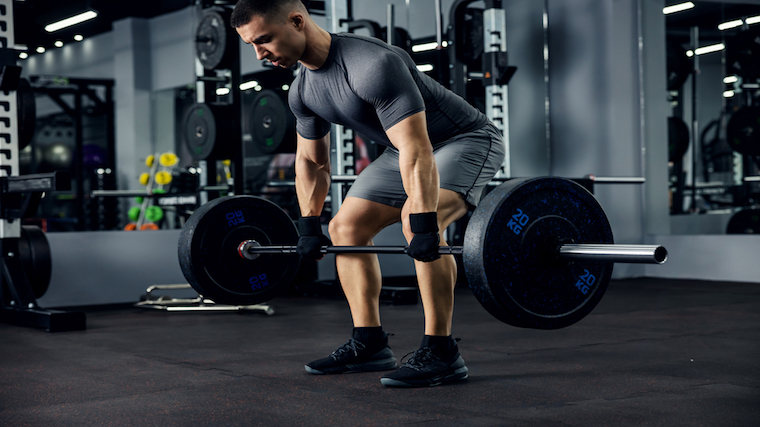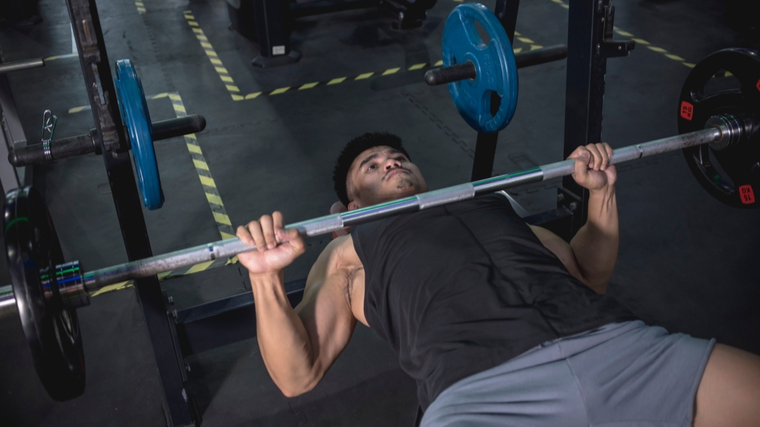When it comes to training programs, there aren’t too many “plug and play” workouts that virtually guarantee results. More accurately, there aren’t too many programs that promise and actually deliver on those results. The 5×5 workout does, and it has a 60+ year track record of success with a trail of strong, muscular, athletic bodies to show for it.
5×5, or five sets of five reps, was first popularized in the 1960s and has developed a reputation as one of the most reliable routines in the long history of weight training. Hit the gym three days a week and do 5×5, eat plenty, and you almost can’t fail.
There are a few exceptions and details, of course, but the 5×5 workout is generally recognized as one of the most dependable ways to build size and strength nearly simultaneously. It’s the original “powerbuilding” workout. Here’s what to know about getting the most out of this classic mass-building program.
The 5×5 Workout
History of the the 5×5 Workout
5×5 isn’t some flash-in-the-pan routine. It’s been delivering results for decades, due in part to its simplicity and to its focus on some reliable training fundamentals — big exercises and heavy weights. Here’s a closer look at some of this program’s hallowed backstory.
Reg Park Built the Austrian Oak
Arnold Schwarzenegger might have the physique that launched a million gym memberships, but what about the bodybuilder who was Arnold’s biggest inspiration? Surely, the person who motivated the person who motivated generations of people to hit the gym should get some recognition.
Reg Park is the classic bodybuilder who inspired a young Arnold to reach for the muscle-building stars. Park won several bodybuilding competitions from the mid-1940s into the 1970s, including three Mr. Universe titles. Park also gained a degree of mainstream popularity starring as the legendary Hercules in several films in the early 1960s.
Park’s powerful, well-muscled frame was a step up from the top bodybuilders of the day. His strength-focused training reflected his ability to “show and go” and it allowed him to become the first bodybuilder to bench press 500 pounds. This contrasted with his bodybuilding contemporaries who often focused on lifting moderate to light weights for relatively high repetitions.
Like some successful bodybuilders of his era, Park published a series of training catalogs and programs to guide hopeful gym-goers along the muscle-building path. One of his books, “Strength and Bulk Training for Weight Lifters and Body Builders,” was published in 1960. This appears to be one of the first widespread recommendation of a structured 5×5 workout, even though using five sets of five reps featured in some parts of “Training for Power,” written by Park in 1954.
In “Strength and Bulk Training for Weight Lifters and Body Builders,” Park advocated for three workouts each week. In each session, three fundamental exercises — the squat, bench press, and deadlift — are performed for five sets of five repetitions. Every training session featured a relatively minimalist approach:
- Weighted Back Extension — 3 x 10
- Squat — 5 x 5
- Bench Press — 5 x 5
- Deadlift — 5 x 5
The back extension was considered essential for strengthening and warming up the lower back. Park recommended a specific approach to each of the five sets. The first two sets were progressively heavier warm-up sets, for example, 135 pounds for five reps and 155 pounds for five reps. The three final sets for each exercise used the same weight, for example, 175 pounds for three sets of five reps.
Park also advised a whopping three to five-minute rest between each of those three working sets. This may sound like an eternity for lifters accustomed to fast-paced workouts, but such long rest intervals have been shown to allow optimal performance when lifting heavy weights. (1)
Park suggested following the basic 5×5 workout plan for three months before progressing to either a “bodybuilder’s workout,” featuring additional exercises like calf raises and barbell curls, or a “weightlifter’s workout” which incorporated lunges, power cleans and other sport-specific movements.
Bill Starr: The Strongest Shall Survive
There used to be a widespread myth among mainstream sports that “lifting weights creates unathletic, muscle-bound bodies.” While we now know that well-designed weight training programs can build stronger, faster, more durable athletes, many professional athletes and coaches used to believe this urban legend whole-heartedly. Until Bill Starr.
Bill Starr was a competitive weightlifter, editor of Strength and Health magazine from 1966 to 1972, and one of the first NFL strength and conditioning coaches as he worked with the Baltimore Colts beginning in 1969. Notably, the Colts won their first Super Bowl in 1971 while under the guidance of Starr’s weight room coaching, landing a significant blow against the “muscle-bound myth.”
Starr was also an advocate of simple and effective basic, heavy lifting. In 1976, he wrote “The Strongest Shall Survive: Strength Training for Football.” The plan laid out a three-day-per week training plan centered around what Starr referred to as “The Big Three” — three exercises which build muscle, strength, and explosive power throughout the entire body.
These priority exercises were the bench press done with a relatively close-grip (hands shoulder-width apart), the power clean (which he called “the athlete’s exercise” for it’s practical carryover to the playing field), and the back squat descending as deep into the bottom position as possible.
The program also incorporated leg extensions and leg curls to warm-up the quadriceps and hamstrings, respectively, as well as sit-ups and leg raises to address core strength. These exercises were done with fewer sets and higher repetitions to avoid excess fatigue. Once a week, the overhead press was also suggested in place of the bench press for athletes looking for even more upper body strength and power.
One cornerstone of Starr’s 5×5 program was a circuit-style approach, where each of the three primary exercises were performed in a superset-style — one set of power cleans, followed by one set of the bench press, followed by one set of squats. This was intended to help build cardiovascular conditioning along with strength and power.
Starr, unlike Park, increased the weight on each of the five sets for every exercise. He also incorporated varied loading parameters on each day. While the 5×5 format was kept constant, the first workout of the week was “heavy” using near-maximal weights. The second workout was “light,” using 80% of the weights moved in the previous workout. The third workout of the week was considered “medium” and called for 90% of the loads used during the heavy workout.
This type of “daily undulating periodization” allowed more efficient recovery because training intensity was adjusted throughout the week. It also encouraged increased power output since relatively lighter weights can be lifted with more explosive power. (2)
How to Program the 5×5 Workout
Setting up a 5×5 workout can be simple, but it’s not quite as simple as just performing five sets of five reps on a few random exercises. While the sets and reps are one defining feature, an effective 5×5 plan also requires several other programming factors.
The Sets and Reps: 5×5
Just like you can’t do a kettlebell swing without a kettlebell, you can’t do a 5×5 workout without focusing on five sets of five. Whether it’s five progressively heavier sets, like Starr’s approach, or multiple sets with the same weight like Park recommended, aim for five total sets per exercise.
Use a load that achieves muscular fatigue within four to six repetitions while performing no more than five repetitions per set. If a load only allows you to complete only four reps before reaching muscular failure or compromising exercise technique, repeat the weight the following week. Basic strength adaptations should allow you to reach the five-rep mark.

Any training with higher rep ranges should be kept to a bare minimum to maintain focus on the 5×5 portion of the workout. Limit additional sets/reps to one or two exercises per workout, at most.
Those exercises should either be single-joint movements such as curls or lateral raises or they should be less strenuous movements like dumbbell rows or split squats. These strategic choices will keep physical and CNS (central nervous system) stress to a relative minimum, allowing overall recovery.
Or, as Park showed the world, you can certainly perform only 5×5 movements in every workout without supplementing higher repetitions. This keeps the program rooted in its primary focus — emphasizing hard work by going “all in” for five sets of five repetitions.
Five-rep sets allow a heavy enough weight to trigger significant strength gains without the high degree of neuromuscular fatigue that can accompany one, two, or three-rep maximums. Performing five sets per movement allows the involved muscles to be put under significant total volume, which is necessary to stimulate muscle growth.
Three Full-Body Workouts Per Week
The nature of 5×5 workouts requires a single exercise per body part. Performing 5×5 for multiple exercises per body part — for example, training several bench press variations for 5×5 in each workout — would likely lead to overtraining by moving too much weight for too much volume with too few muscle groups.
Using multiple exercises per body part per session would also not allow an efficient weekly workout split since only one or two body parts could be trained in each workout. Because the 5×5 is the core programming concept, the workout forgoes multiple exercises per body part. Because a single exercise per body part is used in each session, more muscles can be trained in a given workout.
This is why a full-body approach is the only effective and efficient way to plan a 5×5 workout. Centering the training routine around three weekly full-body sessions, also creates “built-in” rest days to allow muscular growth and recovery. Three workouts mandates four non-training days.
Repeating these types of full-body workouts several times per week also allows a high frequency of training, which has been shown to be more beneficial for strength gains than training once per week. (3)
Multi-Joint Barbell Exercises
Multi-joint (compound) barbell exercises are the preferred movements to accommodate relatively heavy sets of five. This is a matter of efficiency, practicality (barbells are much simpler to load heavy weight), and safety.
Dumbbell exercises can become dangerously unwieldy when using very heavy weights due to the stabilizing muscles needed to control each individual dumbbell. Heavy bodyweight exercises, similarly, can overload stabilizing muscles before the target body part is sufficiently worked.
Focusing on multi-joint exercises, like squats, deadlifts, and presses rather than single-joint exercises like curls or extensions allows you to recruit more muscles with each lift. This creates greater training efficiency while also allowing you to move more overall weight.
In each workout, include a squat, a press (either overhead or a bench press variation), and a “pull” whether it’s a type of deadlift or something that more directly recruits your back muscles like a barbell row.

This will ensure relatively balanced training of both your upper and lower body as well as your “pushing muscles” (chest, shoulders, and triceps) and your “pulling muscles” (back and biceps). With proper exercise selection, your core will likely receive sufficient stimulation without needing direct training.
Benefits of the 5×5 Workout
The 5×5 workout would’ve faded into obscurity decades ago if it didn’t deliver genuine physical benefits. The reason it’s continued to be a staple program for generations is because it can reliably add muscle and power onto nearly any lifter.
Muscular Size
Whether you’re looking to be built like a powerhouse linebacker, a well-muscled bodybuilder, or something in between, the 5×5 workout can be a top choice. The calorie surplus needed to recover from high frequency, heavy lifting coincides with the type of calorie intake needed to support muscle growth.
In fact, one of the surest ways to short-change your results with the 5×5 program is to provide insufficient fuel for growth and recovery. One common mistake some lifters make is to try “eating for fat loss” with a calorie deficit while using a 5×5 training routine.
Without ample calories and enough high-quality protein, you run the risk of wasted time and energy, and potential overtraining.
Total-Body Strength
Performing big barbell exercises with heavy weights for relatively low repetitions is a spot-on approach to building raw strength. Using a limited number of exercises in each workout allow you to focus your training intensity on the most efficient movements.
Performing a relatively limited number of sets and repetitions keeps your workouts focused on classic hard and heavy lifting which also yields focused results.

One worthwhile “side effect” of the 5×5 workout is that high-frequency exposure to the same exercises can help ingrain proper lifting technique. Improved technique can carry over to better long-term gains, greater training efficiency, and potentially lower the risk of injury.
Drawbacks of the 5×5 Workout
While the 5×5 program has several clear benefits, there are also a few opposing points to consider. Any training routine will have its own list of pros and cons; being around for several decades doesn’t give the 5×5 workout a free pass.
Limited Muscular Development
Even though the multi-joint barbell exercises do recruit a number of muscles during each workout, certain body parts will likely remain somewhat undertrained due to specific exercise choice or an individual’s unique limb lengths.
For example, performing the bench press as the primary upper body pushing exercise may leave your triceps and shoulders less-than-fully stimulated depending on your arm length and specific grip width. Performing the deadlift will work portions of your hamstrings, but won’t efficiently train the “leg flexion” aspect of hamstring function which can be achieved through leg curls.
Relatively smaller body parts like the upper back, shoulders, triceps, biceps, and calves receive some activation as supporting muscle groups but aren’t directly trained with a classic 5×5 workout.
This is one reason why the program is well-suited for beginner lifters looking to establish a general base of muscular size and strength — they don’t yet have any significant weaknesses or discrepancies. Experienced lifters sometimes require more precise training to target key developmental weaknesses, which are not effectively addressed by a 5×5 plan.
Limited Cardiovascular Development
With its focus on heavy barbell lifting, and recovering from heavy barbell lifting, the 5×5 workout doesn’t leave any real room for significant cardiovascular training. Research has shown that aerobic training (like running on a treadmill or long-distance biking) can negatively impact explosive strength and power, and may interfere with overall strength and muscle gains. (4)

Just like the 5×5 workout isn’t compatible with a calorie deficit, it’s also not applicable for those with cardio-based goals such as distance running and many general sports. The key exception would be to specifically program 5×5 in the offseason when cardio training can be a lesser priority in the short-term.
Starr did find an effective shortcut around this obstacle by training in a superset or circuit style. If maintaining some semblance of cardio fitness is a secondary goal, consider planning your 5×5 workout similarly. That’s an effective compromise, presuming you have the available equipment to use three barbells in quick succession — a scenario not likely in many commercial gyms, but quite possible in a home gym.
Potential Joint Issues
Training exclusively with barbells can be highly effective, unless you have pre-existing joint issues that preclude you from performing many barbell exercises. This can often be related to general mobility issues — being unable to safely perform a given exercise — or damage from pattern overuse — the results of performing a given exercise repeatedly over the years.
Creative exercise selection could be a temporary solution in some cases, for example, choosing a push press instead of a strict overhead press. However, for long-term joint health and overall progress, a more conservative approach is often to avoid problematic exercises (and implements, like the barbell) altogether.
Sample 5×5 Workout Program
Train three days per week, with at least one day of rest between each session. If you’re hitting the 5×5 exercises as hard as you should be, you’ll quickly appreciate having a day of rest after each workout and a day to mentally and physically prepare before each session.
Each workout includes a relatively limited “accessory” movement at the end of each workout to tack on some additional work for the chest, triceps, back, biceps, and hamstrings. If you’re feeling excessively fatigued on a given day, the final exercise is entirely optional. What’s important, however, is to not add even more exercises or volume to the training plan.
Feel free to experiment (for weeks at a time, not a few workouts at a time), varying between Park’s “three sets with the same weight” approach as well as Starr’s method of increasing the weight on every set.

You might find that you get into a “groove” by repeating the same weight for multiple sets or you could benefit from the dialed-in focus of gradually building up to one very heavy set per exercise. In either case, when you’re able to successfully perform five reps on your fifth set, increase the weight on all sets.
Beginner lifters would be better served repeating roughly the same weight for each workout, increasing whenever the final set reaches five repetitions. More experienced lifters will likely benefit from Starr’s “heavy, light, medium” — the first workout of the week sets the standard, the second workout is programmed with 75 to 80% of the weights, and the third workout uses 85 to 90% of the first workout’s loads. Any required mathematics will payoff with improved recovery between sessions and more powerful performance during training.
Monday
Trap Bar Deadlift — 5 x 5
Overhead Press — 5 x 5
Front Squat — 5 x 5
Dips — 3 x 8-12
Wednesday
Trap Bar Deadlift — 5 x 5
Overhead Press — 5 x 5
Front Squat — 5 x 5
Chin-up — 3 x 8-12
Saturday
Trap Bar Deadlift — 5 x 5
Overhead Press — 5 x 5
Front Squat — 5 x 5
Romanian Deadlift — 3 x 8-12
Simple, Effective, Timeless Training
Like many recipes in the culinary world, great strength training programs don’t need to be overly complicated to deliver an optimal end result. Mastering the basics — whether it’s the perfect omelet or simple, heavy barbell training — builds an effective foundation for beginners. This pared down program can also be a reliable fallback for experienced lifters, under the right conditions, who need a short-term, general purpose plan to refresh their size and strength gains.
Frequently Asked Questions
The primary concept of the program is to use one big compound lift per body part, limiting the session to three key exercises per session. The exercises must be able to be safely and efficiently loaded to a four-to-six rep maximum, while recruiting as many muscle groups as possible.
Many barbell exercises meet this criteria. However, the case could also be made, for example, to use the trap bar deadlift (as seen in the sample workout above) or the leg press. Certain machine exercises, like a machine chest press, T-bar row, or Smith machine squat, likely cannot be safely performed with the necessary load.
Use your judgment but, when in doubt, try to maintain the focus on barbell lifts. There are plenty of variations of basic movement patterns (squats, deadlifts, and presses) and you likely don’t “need” to stray too far off-course.
No. Any type of five-rep isolation (single-joint) exercise, like a heavy barbell curl, triceps extension, or calf raise, gets further from the primary focus of the 5×5 workout — recruiting as many muscle groups as possible per exercise. Unless you’re interested in doing cheat curls (which can be high risk and low reward) to recruit your back and hips into the movement, it’s best to avoid programming isolation movements for 5×5.
Single-leg exercises, like the split squat, or single-arm exercises, like dumbbell rows, will limit the weight you can use relative to a two-leg or two-arm barbell exercise. The added time and energy needed to train both sides will also increase overall fatigue.
Unilateral (single-leg/single-arm) exercises also increase overall stress on your core musculature, especially when moving heavier weights. This can further reduce focus on the target muscle.
References
- de Salles, B. F., Simão, R., Miranda, F., Novaes, J.daS., Lemos, A., & Willardson, J. M. (2009). Rest interval between sets in strength training. Sports medicine (Auckland, N.Z.), 39(9), 765–777. https://doi.org/10.2165/11315230-000000000-00000
- Rhea, M. R., Ball, S. D., Phillips, W. T., & Burkett, L. N. (2002). A comparison of linear and daily undulating periodized programs with equated volume and intensity for strength. Journal of strength and conditioning research, 16(2), 250–255.
- Grgic, J., Schoenfeld, B. J., Davies, T. B., Lazinica, B., Krieger, J. W., & Pedisic, Z. (2018). Effect of Resistance Training Frequency on Gains in Muscular Strength: A Systematic Review and Meta-Analysis. Sports medicine (Auckland, N.Z.), 48(5), 1207–1220. https://doi.org/10.1007/s40279-018-0872-x
- Schumann, M., Feuerbacher, J. F., Sünkeler, M., Freitag, N., Rønnestad, B. R., Doma, K., & Lundberg, T. R. (2022). Compatibility of Concurrent Aerobic and Strength Training for Skeletal Muscle Size and Function: An Updated Systematic Review and Meta-Analysis. Sports medicine (Auckland, N.Z.), 52(3), 601–612. https://doi.org/10.1007/s40279-021-01587-7
Featured Image: Jacob Lund / Shutterstock
Trending Products

FITINDEX Vibrating Foam Roller 5-Speed , Next Generation Electric Foam Roller for Muscle Relax, Fitness Deep Massage…

Resistance Bands for Working Out with Exercise Guide. Fabric Booty Bands for Women Men. Workout Bands Leg Bands for…

GAODI Women Waist Trainer Vest Workout Slim Corset Neoprene Sauna Tank Top Zipper Weight Loss Body Shaper

FITNE Green Tea Herbal Honey Lemon With Garcinia Senna Infusion Gentle Detox Cleanse High Antioxidant No Calories Stevia…

Sunny Health & Fitness Squat Assist Row-N-Ride™ Trainer for Glutes Workout

FITNE Black Currant Herbal Green Tea Fruity Garcinia Senna Infusion Gentle Detox Cleansing Boost Antioxidant Wellness…

Cork Squat Wedge Block 2PCS Non Slip Professional Squat Ramp,Squat Platform for Heel Elevated Squats and Calf Raises…








